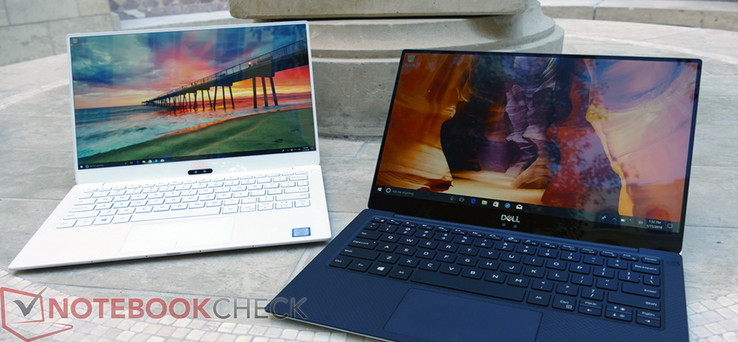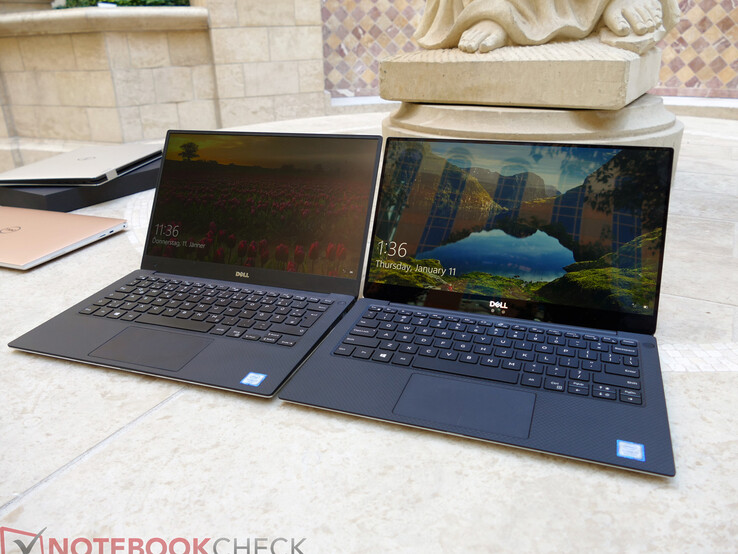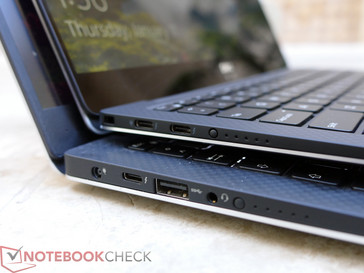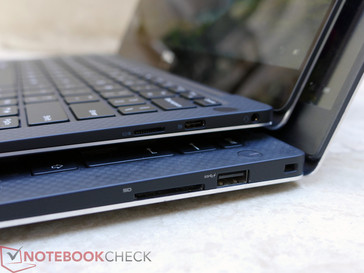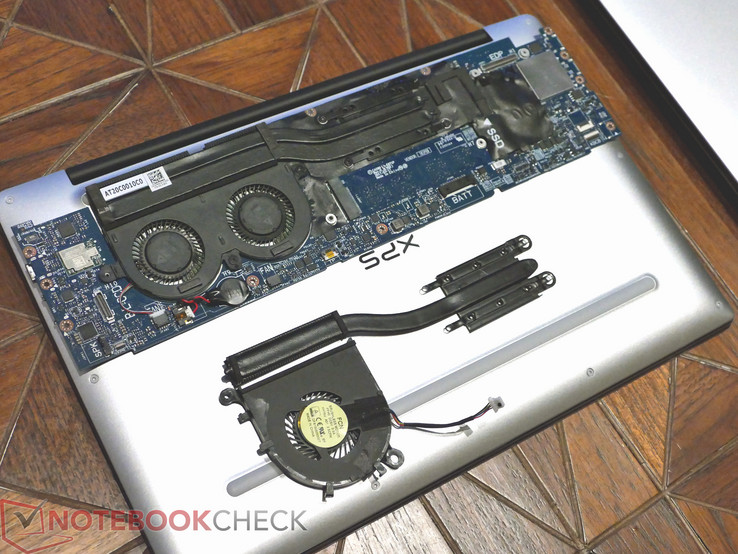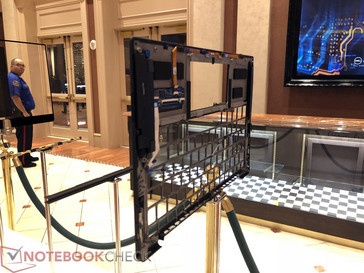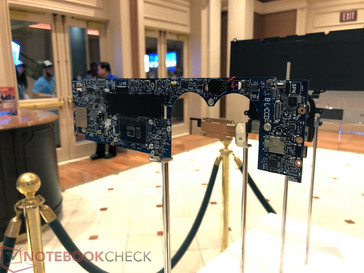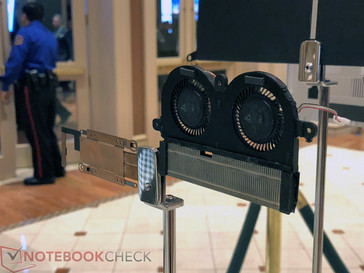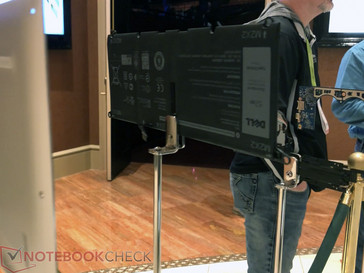Editorial: Dell XPS 13 9370 - not bad, but where's the beef?
The Update We Have All Been Waiting For
After Dell had started showing off the new XPS 13 to various media outlets last fall, everybody pretty much knew a redesign was imminent. Following the current trend to ever slimmer notebooks, Dell’s bestseller was about to receive a brand-new case. What exactly does slimmer mean in this particular case? The XPS 9360 was (or rather still is) officially specified with a thickness of 9 - 15 mm (~0.35 - ~0.6 in) and a footprint of 304 x 200 mm (~12 x 7.9 in; width x depth). In return, the new 2018 model (9370) is advertised with a thickness of 7.8 - 11.6 mm (~0.31 - ~0.46 in) and a footprint of 302 x 199 mm (~11.9 x ~7.8 in). In other words: the already very narrow bezels have become even smaller (5.2 mm/~0.2 in before, 4 mm/~0.16 in now) and the older model is a whopping 1 mm (~0.04 in) deeper than the new one. Strictly speaking, the footprint has thus remained pretty much the same. However, at just 7.8 - 11.6 mm (~0.31 - ~0.46 in) thickness, the new model is between 1 and 3 mm (~0.04 and ~0.12 in) slimmer than the old one.
We have had the opportunity to take a closer look at the new XPS 13 9370 during CES, and were able to compare the two models directly. Not only does the XPS 13 9370 look significantly slimmer than its predecessor, it also feels much more slender and elegant even though there is absolutely no difference in weight whatsoever: 1.2 kg (~2.6 lb) for the 9360 base model (1.29 kg/~2.8 lb for the touchscreen model) versus 1.2 kg (~2.6 lb) for the 9370. According to Dell, the touchscreen model isn’t any heavier than the non-touchscreen model.
old vs. new: Dell XPS 9370 (4K touch) compared with its predecessor (FHD matte)
The Flip Side of Dell’s Craze for Slimness
Don’t get us wrong: slim can be very sexy and graceful, but as expected, it comes at a price: Dell has had to sacrifice practically all ports for the sake of a slimmer chassis. Even those that are still commonly in use and immensely important in our opinion, such as USB Type-A. While the predecessor featured two USB Type-A ports, the 9370 requires an adapter. Granted, Dell has promised to include the necessary dongle in the box, but that does not really solve the problem that pretty much every USB device from mice and keyboards (or wireless dongles) to smartphones for transferring photos/videos or charging to the still very commonly used thumb drives will necessitate the use of one or more dongles (or even a USB hub). In other words: the pain of an expensive dongle life with absolutely no gain whatsoever (disregarding the more than scarce USB-C peripherals with their rotationally-symmetrical connector of course).
The USB-C way of life, started by Apple does not really have any benefits for end users.
The number of ports is another issue, and the new 9370 model features fewer ports than its predecessor. Where the old model had two USB 3.0 Type-A and a single Thunderbolt 3 port, the new model features two Thunderbolt 3.0 and a single USB 3.1 Type-/c ports. Sounds identical at first glance, until you need to charge your brand-new Dell XPS 13. Unlike the old model, the 9370 charges through USB-C only, which means that one of the three available ports is already pretty much reserved for charging and powering the device. The 9360 still had a dedicated power port. Assuming you need to connect to an external display via another of the USB-C ports, just one free USB port remains.
And it gets even worse. The full-size SD card reader has been replaced with a microSD card reader. The SD card reader on the old XPS 13 9360 was one of the fastest card readers that we have ever seen (more than 200 MB/s), and it was perfect for users who had to transfer large amounts of data to or from SD card. You can obviously switch to microSD instead, but that translates to fewer high performance heavy-duty memory cards (think 4K) available at higher costs. Another option would be data transfer via cable, assuming you have at least one port available on the device to connect to. Which, as we have talked about before, might get a bit tricky. Once again we have to conclude: more pain (cable tangle, cost), no gain.
What else?
In previous tests, the dual-core equipped XPS 13 has always performed exceptionally well regardless of exact specifications. Most notably, all XPS 13 models have performed brilliantly under sustained load and were able to maintain their high initial level of performance over long periods of time. Surface temperatures were fairly low, particularly around the palm rests and the keyboard itself. Unfortunately, the most recent 9360 iteration, equipped with Intel’s latest Kaby Lake-R processors (i5-8250U review and i7-8550U review) started to throttle after a few minutes of load, and for the first time in any XPS 13 review, surface temperatures crossed the 50 °C (~122 °F) threshold. In other words: the 9360 design is unable to cope with Intel’s latest CPU generation’s thermals.
The new XPS 13 features the exact same CPUs (Intel U-series quad-cores) but is up to 3 mm (~0.12 in) slimmer. It is very obvious that this has to have implications on thermal management, and the 9370 is living proof that Dell had to dig deep to address the issue. First of all, a special layer called “gore” has been introduced underneath the keyboard in order to keep it cool. Second, this bottled up excess heat that is now unable to interchange with the environment through the keyboard surface is now taken care of by two fans instead of one. And third, the number of heat pipes has been increased from one to two.
Truth be told we are very excited and can’t wait to find out how well the new XPS 13 is going to behave under sustained load. We do expect the new cooling solution to improve upon the current heat dissipation strategy and keep a lock on Intel’s latest generation of processors to maintain their high level of performance over long periods of time without throttling. If, however, the new cooling solution fails to achieve that, its one and only benefit will be the fact that it allows for a slimmer case instead of simultaneously improving upon the predecessor’s thermal management capabilities that have been pushed beyond their limits by Intel’s latest ULV quad-core lineup.
Worst-Case Scenario
One particular topic shall not be swept under the rug: the XPS 13’s infamous coil whine caused by high-frequency vibration of electronic components. We have been able to witness this notorious issue on several of our XPS review units in the past few years, as well as some Latitudes, and occasionally also other manufacturers’ laptops. It is safe to assume that not all XPS 13 notebooks are affected, and coil whine characteristics differ from one unit to another. Sometimes, the coil whine is so quiet that it blends into the ambient noise. Other times it is only noticeable occasionally. All in all, coil whine on the XPS 13 remains a mystery. Dell is certainly aware of the issue, which we have been able to confirm in several conversations with various Dell employees in the past few years.
The good news is that the brand-new XPS 13 9370 features a completely redesigned motherboard and many brand-new components. We are thus confident that Dell has successfully addressed the issue and has rid the XPS line from its infamous coil whine for good. If, however, the new model still exhibits the exact same issues as the old one it could become this generation’s most prominent nail in the coffin.
Less is More
And while we are on the subject of putting nails in coffins, there is another regression that will leave potential buyers “not amused”: the reduced size of the battery. Slimmer case almost always equals smaller battery, and in this case it has dropped from 60 Wh (9360) to 52 Wh (9370) in absolute, or by 13% in relative numbers. Considering that CPU, GPU, and other internal components such as the display have remained absolutely identical, it is safe to assume that the new model will have a shorter battery life than the old one. Plus, the recently introduced 4K panel for the 9370 will hog even more energy than the 9360’s QHD+ panel. According to Dell, the 9370 FHD model should last for 19:46 hours in Word or Excel while the official battery life for the predecessor was quoted at 22 hours in MobileMark 2014. Since these two benchmark settings are completely different, the two results are not comparable in any meaningful way.
In our own tests, the top-tier 9360 (8550U, QHD+) lasted for around 10 hours in our real-world Wi-Fi test. The i5-8520U model ran for 1.5 hours longer. A 13% smaller battery would result in a 1 - 2 hour decrease in battery life. It would still be very decent, but all in all a significant drop. We will have to wait for our upcoming reviews to find out for sure.
All Good?
The slimmer case comes at an ostensibly high price. Connectivity and battery life are worse than they were before, weight benefits are non-existent, and we cannot make any meaningful statements in terms of performance and emissions just yet.
We have to ask ourselves whether or not it’s really worth paying the price in order to shave off 2 mm (~0.08 in) of thickness to end up with a 13 (~0.5 in) instead of 15 mm (~0.6 in) slim notebook. Would it not have been much better to reduce the device’s overall weight, improve upon battery life, add another Type-C/Thunderbolt port (instead of the power port), and ensure a high level of performance by improving upon thermal management and emissions?
Our extensive review will show how well the Dell XPS 13 9370 is going to perform in real life. As always, we are going to look at the various available models and compare them very thoroughly with each other as well as their predecessor. Who knows, maybe the 9370 will surprise us and become the new de-facto sub-notebook standard that all future notebooks will have to measure up against. We have ordered our review samples and expect them to arrive in the coming 1 - 2 weeks. Stay tuned.




